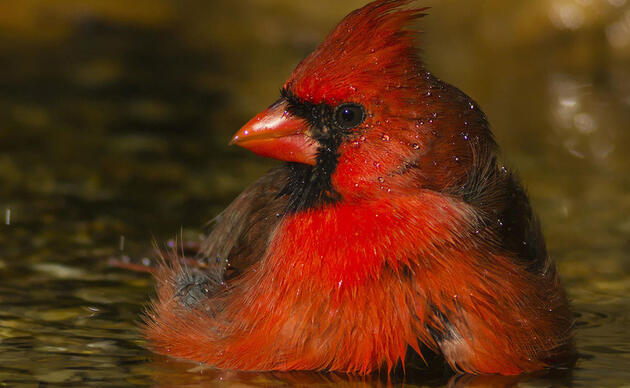Richard T. Paul Alafia Bank Sanctuary is leased from and managed in collaboration with The Mosiac Company and Port Tampa Bay. The Alafia Bank (Bird Island to the east; Sunken Island to the west) is a Critical Wildlife Area as designated by the Florida Fish and Wildlife Conservation Commission (FWC). Located in Hillsborough Bay at the mouth of the Alafia River, these two human-made islands were formed from spoil material when a channel into the Alafia River was dredged in the late 1920s. The islands were immediately important as bird nesting sites for gulls, terns, and skimmers. As shrubs and trees replaced low-lying vegetation, nesting herons, egrets, ibis, and later pelicans moved from the historic nesting site at Green Key. Each year, up to 18,000 nesting pairs of 16 to 20 species of birds nest on the Alafia Bank, making it one of the largest colonies in Florida and one of the most diverse colonies in the continental United States. Both islands and the surrounding water buffer are closed to public access year-round.
The islands are protected from erosion by over a mile of living shoreline that reduces the wave energy that reaches the islands, while providing substrate for oysters that filter the water and benefit wildlife. Learn more about that project.
Green Key and Whiskey Stump Key, also in Hillsborough Bay, are the original Tampa Bay Sanctuary islands. Protected since 1934, the birds of Green Key moved to the Alafia Bank islands in the 1960s. An unspoiled mangrove island, Green Key today provides important foraging and loafing habitats for birds. The seagrass meadows and oyster bars around the key are excellent bird feeding sites. Whiskey Stump Key, a quarter-mile away, was the site of the warden's residence from 1934 until the 1960s. In a quiet stand of cabbage palms on this natural island stands a monument erected in memory of Dr. H.R. Mills, a Tampa pathologist who was the driving force behind the establishment of the Sanctuary and for many years its strongest supporter.
Nina Griffith Washburn Sanctuary is located in Terra Ceia Bay. Protected by Audubon wardens since 1939 and now owned by the Florida Audubon Society, this beautiful natural mangrove key historically supported a large breeding colony up to 4000 pairs of pelicans, cormorants, herons, egrets, ibis, and spoonbills. In recent years, the island has been used for roosting and foraging Reddish Egrets, Roseate Spoonbills, and other wading birds.
Cortez Key Sanctuary in northern Sarasota Bay was leased by Audubon from the state in 1981. Cortez Key hosts a nesting colony of Brown Pelicans, Double-crested Cormorants, and Great Egrets. The lovely mangrove island is surrounded by shallow seagrass meadows, valuable fish nursery habitat. Several hundred Magnificent Frigatebirds roost at Cortez Key during the spring and summer.
Whale Key and the Town Islands in Sarasota Bay have been protected by the Audubon Society since 1974 through a lease from the state. These lovely mangrove islands and their surrounding shallow seagrass meadows provide excellent feeding and resting habitats for birds.
Dot Dash Dit Critical Wildlife Area at the mouth of the Braden River consists of three small mangrove islands (Dot, Dash and Dit!) and is the home of the only coastal colony of Wood Storks in the Tampa Bay area. The three islands are designated as a Critical Wildlife Area by the Florida Fish and Wildlife Conservation Commission, and subject to seasonal restrictions.
Roberts Bay Critical Wildlife Area is three small mangrove islands just south of Sarasota. Roberts Bay is an important colony for Brown Pelicans, Great Blue Herons, and Great Egrets. The Roberts Bay Islands are managed by the Sanctuary with permission of the Florida Division of State Lands. Sarasota High School ecology students have played an important role in protecting this site, helping to construct a breakwater to protect the islands from erosion, and participating in nesting surveys and fishing line removal projects.
Sand Key West in northern Clearwater Harbor is the site of a small colony of pelicans, herons and egrets. This island has deteriorated in recent years due to shoreline erosion, but Audubon is working on a living shoreline breakwater to protect this small island from disappearing.
Marker 26 is a rocky spoil island in St. Joseph Sound dominated by Brazilian pepper. But the pepper provides a nesting substrate that can tolerate an amazing amount of guano from some 300 pairs of nesting cormorants, egrets, herons, spoonbills, and ibis.
How you can help, right now
Donate to Audubon
Help secure the future for birds at risk from climate change, habitat loss and other threats. Your support will power our science, education, advocacy and on-the-ground conservation efforts.
Become a Monthly Donor
Donating monthly is flexible, easy and convenient and makes you a champion birds can count on, no matter the season.
Volunteers Needed
Florida's birds and wildlife need your time and energy. Learn how you can become a citizen scientist or a volunteer at one of our nature centers today.




